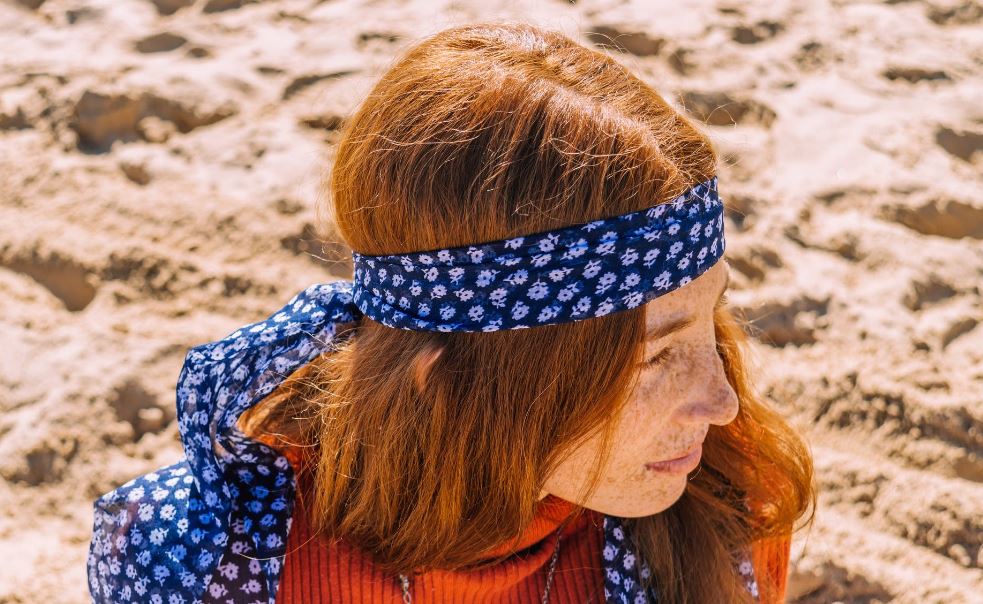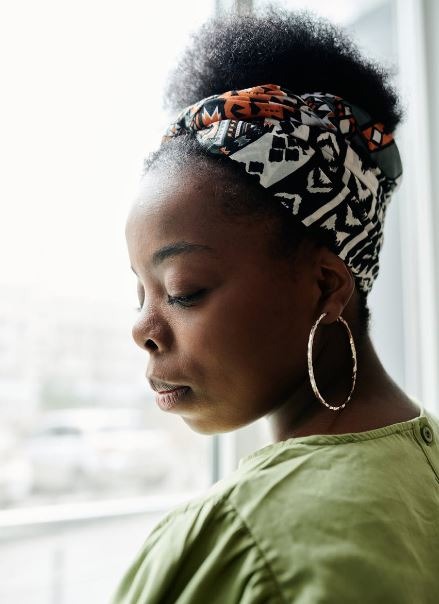A headscarf is the supreme beauty savior for as many motives as there are ways to wear one. Do beach hair scarves protect your hair? Yes, a scarf not only protects your scalp from UV rays and masks a poor hair day, but it also incorporates a trendy touch to your style.
Unfortunately, the heat can drive us to go into a style rut – hair can become limp when worn down, and you can only rock a plain ol’ pony far too many times before you get tired of it. That’s where a simple scarf can help.
There are a thousand various looks you can create with a scarf, from boho to retro, and many types either lend a little flare to weighed-down tresses or help keep unwanted hair out of your face.
It can be difficult to create a good wrap on your own, but a simple step-by-step tutorial can make all the difference.
Here are several ways and steps for tying a headband scarf to help you become beach-ready.
Forehead Scarf
- Start by folding a scarf longways to make it about three inches wide.
- Wrap your scarf around the forehead.
- To prevent looking like the Karate Kid, tie the scarf behind your head rather than on the side.
Head Scarf
- Wrap a huge scarf around your forehead.
- Bring the scarf tails around to the back of the head.
- Tie the scarf in a stiff yet comfortable bow at the back of your neck (the scarf must rest at the nape of your neck). This distinguishes between the stylish and pirate look.
Banded Scarf
- Insert a long scarf into a clear elastic band. You should place the elastic in the center of the scarf.
- Spread the scarf’s ends out.
- Wrap the scarf around your hairline and the top of your head.
- Tie the scarf around your head in the back. Wrap one end of the scarf over the neck and rest it on your shoulder. It provides a splash of color to the overall aesthetic.
Head Wrap
- Wrap a long scarf over your hairline, folded longways.
- Tie the scarf around your neck at the nape.
- Pull the scarf’s end to one part of your neck so you will see it when you look into a mirror. Make a bow out of the ends for an extra-cute look.
Headband
- Create a side braid.
- Grab a short scarf and fold it longways to make a narrow scarf.
- Wrap the scarf over your hairline and tie it off at the beginning of your side braid. The tie will give the braid a “decorated” appearance.
- To finish the outfit, add charming aviators or boho sunglasses.
Head Tie
- Longways fold a small or large scarf.
- Wrap the scarf throughout your neck and pull the tails above your head.
- Tie the tails into a bow and place it on top of your head.
- Adjust the scarf to sit slightly to one side and add “sass” to the outfit.
Front Twist
- Fold a huge scarf longways and place it behind your head.
- Wrap the ends around your head and fasten them at the hairline.
- Twist the leftover scarf ends tightly.
- Wrap the twisted ends around your head and tie them together in a double knot.
Vintage Wrap
- Make a triangle by folding a long scarf in half.
- Put the longest straight end on top of your head.
- Bring the scarf tails forward and delicately crisscross them beneath your chin.
- Make a lovely bow with the ends or knot them loosely.
Triangle Wrap
- Make a triangle by folding a long scarf in half.
- Place the longest straight end across your forehead.
- Wrap the ends around your head and bind them once (do not create a knot).
- Bring the free ends to the front of your head and bind them at the brow.
- Tuck the leftover loose ends of the scarf back into place.
Loose Twist
- Wrap a wide scarf around the back of the head in half. Make sure some of the scarf is freely hanging out (some of the scarf must be hanging on the neck).
- Bring the tails forward and knot them off at the hairline.
- Twist the leftover loose ends together tightly.
- Bring the twisted ends around your neck and knot them off above the nape of the neck.
What Kind of Scarf Should You Wear?
Rectangular Head Scarves
Depending on your preference, these scarves can also be referred to as long or oblong scarves! They aren’t quite as versatile as their precisely square counterparts, but they have some advantages. If you enjoy the look of excess fabric falling or want to wear a turban or full headwrap, you should go with a rectangular shape.
Square Head Scarves
These are the best to work with for the widest range of hairstyles but make sure you choose a large scarf for your desired style. It should be at least 28 x 28 inches in size if you want it to wrap all or most of your head.
For more information on beach headband scarves, you can look at this guide to beach headscarves.
Scarf Fabrics
Headscarves are available in a variety of fabrics. These fabrics are available in a wide range of patterns and colors. Here are the benefits and drawbacks of various textiles.
Silk
Silk is a durable and breathable fabric that drapes beautifully and feels luxurious and gentle on the head. It breathes and soaks up sweat because it is constructed of natural fibers. The bows put on silk scarves are particularly lovely.
Depending on the fabric’s weight, you can wear silk in all seasons. It is more delicate than some other fabrics and must be handled cautiously.
Cotton
This fabric is cool, lightweight, pleasant, absorbs sweat, is sturdy, does not slip, is breathable, and is suitable for all seasons. However, cotton can be too thick for wrapping on the head at times.
Chiffon
Chiffon is a low-slip, easy-to-wash, and long-lasting fabric. It has a more formal appearance than cotton and is lightweight, allowing it to dry rapidly. This fabric also drapes well, albeit not recommended for cold weather, and may not be as soft as other options.
Rayon and Viscose
These fabrics have a great feel and drape to them. Most are machine washable but check the washing directions beforehand. They do not, however, drain away moisture like some other textiles.
Cashmere and Wool
Lightweight wool scarves are ideal for cool weather. Wool is a natural, airy material that resists moisture. Choose scarves that are not too thick since they will be overly bulky when wrapped on the head.




